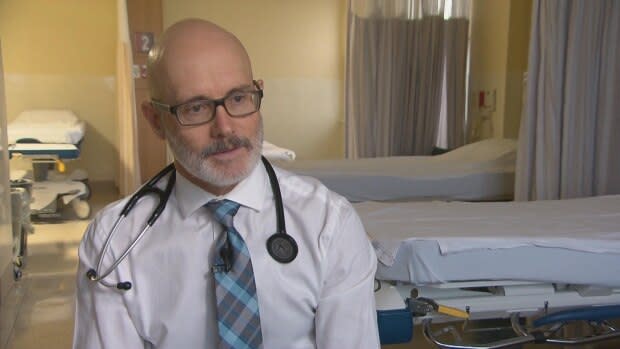Woman is 3rd person this year diagnosed with Creutzfeldt-Jakob disease at the Moncton Hospital
Diana Paterson is not sure how much longer she has to live.
In June, she was diagnosed with Creutzfeldt-Jakob disease, known as CJD, after showing signs of the fatal illness for several months.
Art Paterson, speaking with his wife's permission, said Diana now suffers symptoms of dementia, which came on quickly.
"It's like all of a sudden you walked into a nursing home and you don't know the person you're with," Art said.
When the couple went to Toronto to see a baseball game in April, it was the first time he noticed something was off.

Diana became agitated and couldn't sit still, and they ended up leaving part way through the game, despite Diana's love of the Blue Jays.
Thirteen falls, a six-week hospital stay and numerous tests later, the couple received the diagnosis. Art can't pronounce Creutzfeldt-Jakob, but he knows its prognosis well.
"It's downhill and you're never going back up," he said.
In the seven months since she first started showing symptoms, Diana has lost her short-term memory and can no longer walk unassisted.
"I do everything for her that I can, get her mad, make her laugh, do all the laundry, cook all our meals, whatever," Art said. "That's what husbands and wives are about."
'What the heck is going on?'
While CJD is said to occur at a rate of only one in a million people, Diana is the third person to be diagnosed with the deadly degenerative brain disease at the Moncton Hospital in less than a year.
"You just kind of throw your hands up in the air and say, 'What the heck is going on?'" said Art.

After his wife's diagnosis, Art went online looking for more information. He found two other CJD cases had made the news earlier in the year.
Like Diana, both underwent cataract surgery at the Moncton Hospital before their diagnoses. She had her surgery in December 2016. The other two patients had their surgeries in December 2018 and January 2019.
But unlike Diana, both were already showing signs of the disease at the time of surgery.
Dr. Gordon Dow, division head of infectious diseases at the Moncton Hospital, said even he was shocked when another case of CJD was discovered.
'Flabbergasted'
"I was flabbergasted initially when I saw that we had three cases of this rare disease in a small city the size of Moncton," Dow said.
He immediately contacted the Public Health Agency of Canada, which runs a national surveillance system for the disease. He said the agency scrutinized each case, and he believes there is no need for people to panic.

"I think even though there's the overwhelming weight of evidence suggesting that we've had a cluster of sporadic cases, there is no need for public alarm," Dow said.
"This is not an indication that there's been an outbreak of CJD."
Dow said he found several factors that could explain why Moncton is seeing an increase in CJD diagnoses.
Testing has improved
"Up until now, the only definitive diagnosis was [done through an] autopsy or brain biopsy," said Dow.
He said within the last two years a new method of testing for CJD has been making it much easier to diagnose living patients.
"It has literally revolutionized our ability to diagnose this disease, which is probably more common than we realized," said Dow.
He points to national numbers that show an increase in CJD cases in the last 21 years in Canada, with the mortality rate rising steadily from 0.79 in 1998 to 2.09 in 2018.
As well, Dow said, the city has the largest cohort of neurologists in the province at its two hospitals. With neurologists and geriatricians best equipped to diagnose the disease, a diagnosis that might be missed elsewhere would get picked up in Moncton, he said.

With all three CJD patients having had cataract surgery at Moncton Hospital, Dow said the first concern he had was whether there was any chance that could have caused CJD. He turned to Public Health for information and looked at studies done around the world. He found there is no evidence of a link.
"There's no scientific evidence that cataract surgery can cause CJD," he said.
CJD is most often found in older people, and the elderly receive most cataract surgeries, Dow said. A symptom of CJD is blurred vision and blindness, issues that lead to people receiving cataract surgery.
Types of CJD
According to Dow there are four kinds of CJD:
Iatrogenic (through hospital or medical procedures).
Familial (through hereditary link).
Sporadic (spontaneously occurring for no apparent reason).
Variant CJD (BSE or "mad cow" disease).
He said the two earlier cases of CJD were determined to be sporadic, and for confidentiality reasons he would not discuss Paterson's results.
Dow said he doesn't see a reason for the public to be concerned but, "if we keep seeing further rates of CJD rising in the Moncton area we're going to treat every case as a unique and important case," he said.
"There's going to be a lot of scrutiny."

